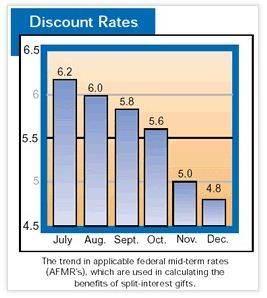During good economic times, it may make relatively little difference if an estate or trust distribution takes twelve months or twenty-four months. In lean times, however, when funding may be harder to come by, it is important that the process of making certain estate gifts are distributed in a reasonable amount of time receives extra emphasis.
When there is general economic expansion, growth in asset values can make it possible to actually distribute more than an estate was worth at the death of a donor. In such cases, dividends or interest income can also be more than sufficient to cover the expenses of administration. In times of low interest rates and slower or no growth in asset values, however, estates tend to stay open longer, and fees are more likely to reduce the amounts finally distributed from an estate. This can have an especially significant impact on residuary bequests—often the largest ones received by charities—as the growth or reduction in estate values is fully reflected in those bequests.
In the current environment, when other gift sources may not be as certain, it is more important than ever that gifts from estates be received as quickly as possible. Consider, for example, instances of large estates reported in the November 1, 2001 issue of The Chronicle of Philanthropy:
- Three New England institutions will share an $86 million bequest from a former stockbroker who died this past August.
- An editorial cartoonist for the Washington Post who passed away in October left over $50 million to charity.
- The second of two sisters who passed away in January left $18.4 million to a school they attended. One was a former government employee, while the other was a teacher and stock market investor.

At 6% interest, the cost of delay in receipt of the above mentioned bequests to the recipient organizations would be $770,000 per month! The difference between receiving the bequests in one year versus two is $9,240,000, and if it took three years to receive the bequests instead of one, the cost of the “float” is $18,480,000.
As the saying goes, “time is money,” and that is certainly true when it comes to the reasons to have adequate oversight of estate administration where charitable dispositions are included. Experience shows that organizations with systems in place to monitor the estate settlement process will tend to receive full or partial distributions sooner than those that do not.
While a complete discussion of the steps involved in the effective administration of estates is beyond the scope of this article, here are a few tips that may help speed up the distribution and maximize the amounts received:
- Pay special attention to residuary bequests, i.e. those that leave amounts to charity after leaving specific amounts to others. As these bequests can not be received until all expenses are paid and the estate is otherwise ready to close, these often take the longest time to settle. After a reasonable time period, 18 months for example, it may be wise to begin making regular inquiries as to the status of the bequest.
- Review settlement sheets. If your bequest comes from the residue, pay special attention to sales of real estate and other assets that are not sold on public exchanges. Remember that every dollar that is not received because of a “below market” sale price reduces the charitable bequest.
- Pay attention to legal and executor fees. Again, if the charitable bequest comes from the residue and other heirs receive specific amounts, only the charitable legatees may have a monetary interest in making sure fees are reasonable. Statutory fees that a court will regularly allow without question can be out of proportion in some cases to the amount of work actually performed.
- Make calls to executors of all estates that have been pending for a period of time at the end of the year. It may be possible to receive a partial distribution prior to the end of your fiscal year.
These steps can not only help to minimize problems with the estate settlement process, but can speed the process up as well. As this year comes to a close, take action now to assure the most bequest income possible, and make a New Year’s resolution to ensure that your organization is monitoring estate distributions in a consistent and resolute manner.

